In 1962, Kennedy was in the White House, Ray Charles was singing “I Can’t Stop Loving You” on the radio, and the Italian motorcycle company known for its high-performance racing machines premiered an on/off-road motorcycle for the American market. The Ducati Scrambler wasn’t the fastest bike on the track or gnarliest in the dirt, but it was fun, and in the age of Camelot, that was enough.
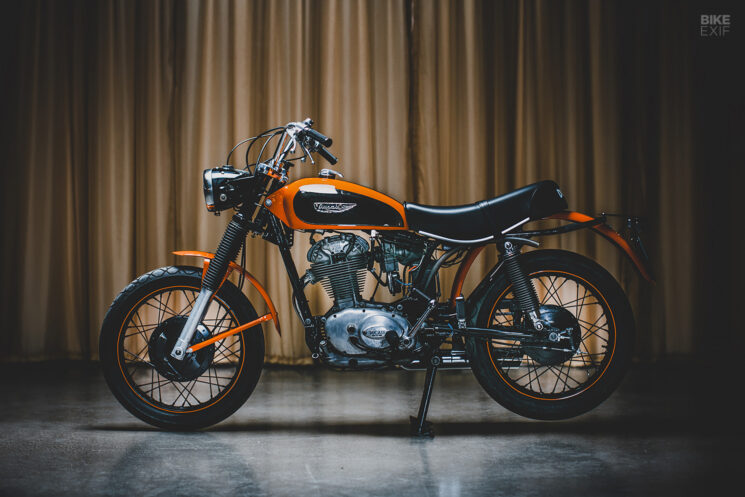
Classic | 1969 Ducati 350 Scrambler
Air-cooled, four-stroke, single-cylinder, SOHC 336 cc | 24 hp | 291 lbs | 5-speed
The Scrambler was the brainchild of Joseph Berliner, president of the Berliner Motor Corporation. Founded in 1951 and located in Hasbrouck Heights, NJ, Berliner Motor Corporation was the U.S. importer of Ducati, Moto Guzzi, J. B. Matchless, and Norton. This made Berliner one of Ducati’s best customers, a fact which gave him a great deal of influence over the design of new products.
Joseph Berliner was a Hungarian Jew. He avoided the Nazi gas chambers at Auschwitz by using the skills learned in his father’s shop fixing radios, bicycles, and motorcycles to maintain German military vehicles. He and three siblings would be the only ones in their family to survive the Holocaust.
The Berliners immigrated to the U.S. in 1947. By 1951, Joseph and his younger brother Michael became the only importers for Zundapp motorcycles east of the Mississippi.
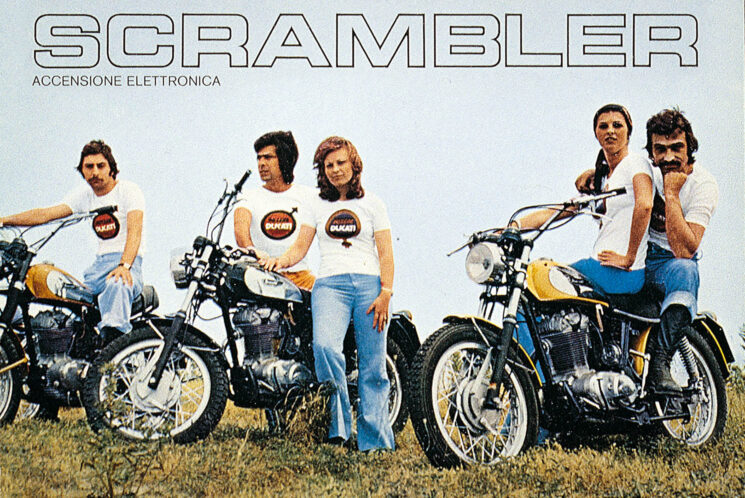
In 1957, Berliner Motor Corporation started distributing Ducati in the U.S. During one of Joseph’s trips to visit Ducati, he showed sketches of a new motorcycle idea to Fabio Taglioni, Ducati’s chief designer, and asked him to develop a motorcycle that would capture the American spirit. The post-war years were a time of American prosperity, and the nation was filled with a sense of youth and optimism. This machine would come to embody the sense of vitality that was the zeitgeist of the time.
The first Ducati Scrambler was a modified Ducati Diana, Ducati’s first 250 cc single-cylinder with a single overhead camshaft engine. Alterations to the frame put the riding position more upright, giving the rider greater stability. Berliner sold the Scrambler as a four-in-one motorcycle capable of road touring, road racing, dirt track racing and scrambling, all with a simple change of tires.
Ducati also offered a plethora of extras so that riders could customize the machine to the riding they intended to do. If you were looking to use the scrambler for the dirt track, they included a pair of rigid frame members to replace the rear shocks. If you wanted to make the ton, three different rear sprockets – a 45, 50, and 60-tooth – were available to mix and match.
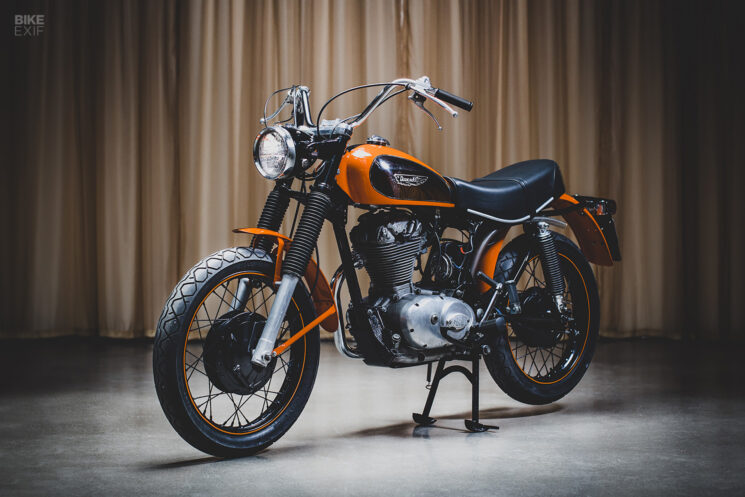
Ducati Scramblers were made in two series. The first was the narrow engine case models, produced from 1962 to 1968, with a 350 cc model going into production in 1967. The second series featured the wide engine case, and was produced from 1969 until 1976 when the Scrambler went out of production. This series would include the 250, 350, and 450 cc models. There was also a 125 cc model produced for the European market. Ducati considers these wide case models their true Scramblers, and they were their bestselling motorcycle of the 1960s.
On a cold February morning and a world away from riding weather, I talked to Del Thomas, who has brought one of these amazing machines back to its former glory. Del is 42 years old and lives in southwest Michigan. He is an engineer by education with a curated collection of motorcycles, including six Ducatis.
Three years ago, Del started on a project to restore a 1969 350 Widecast Scrambler from four different Scrambler parts bikes he had acquired. According to Del, this was a “bitsa bike,” meaning a bit of this bike and a bit of that bike (cue Johnny Cash’s “One Piece at a Time”).
The ’69 Scrambler is Del’s first restoration. He’s been primarily involved with custom motorcycles, but when he saw the dilapidated condition of the Scrambler, something inside him told him that this bike needed to be made anew.
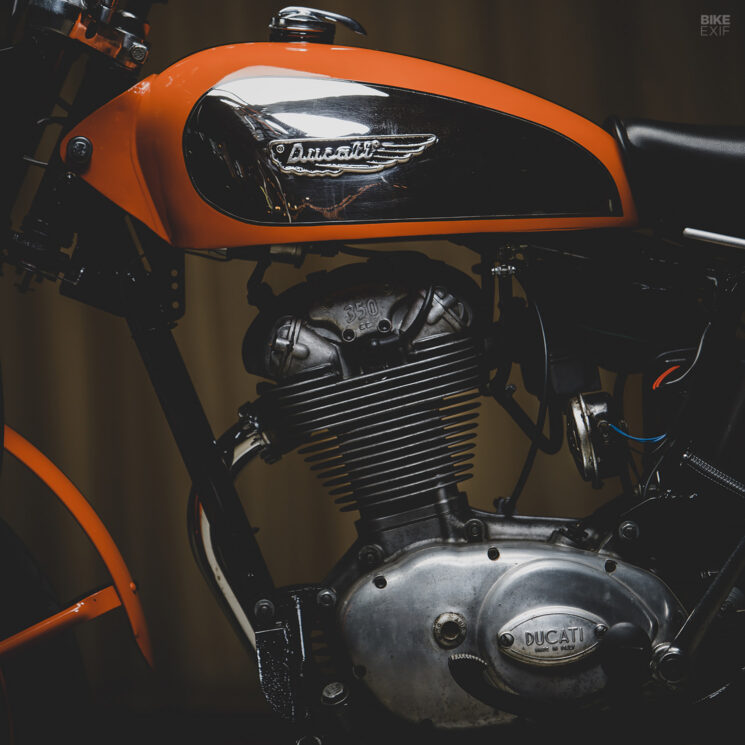
“There is a piece of me that appreciates reviving the old and the dead. There’s a lot of time and effort and detail that goes into the customs, but with this one, there was a lot more love.”
And that love is being returned. While attempting to store the bike for the winter at a local Honda dealer, the bike literally stopped traffic as people pulled off the road in order to gaggle around and gawk at the newly restored machine. As soon as the owner of the dealership realized what was happening, he offered to put the bike in the showroom. Now, Motoworks in Chicago has it on display. “At this point,” Del says with a chuckle, “it’s spent more time on display that it has with me riding it. Eventually, I’d like to get it back.”
You have to marvel at the improbability of this machine: an all-pur- pose bike built for Americans by an Italian manufacturer known for its racing machines at the request of a Hungarian refugee who could easily have been one of the 6.5 million people murdered by the Nazis. Fifty-three years after Joseph Berliner’s vision was first realized, new life continues to be breathed into that legacy.

Contemporary | 2015 Scrambler Ducati
Air-cooled, four-stroke, “L”-twin, desmodromic SOHC 803 cc | 75 hp | 375 lbs | 6-speed
A motorcycle can be more than the sum of its parts. It can be a symbol, a beacon, a lighthouse on a craggy shore that lets us know exactly where we are in space and time. By looking at the new Ducati Scrambler, we might be getting a glimpse of who we are and what we want.
Much like the original Scrambler of the 1960s and 70s, the impetus behind the current incarnation is to capture the imagination of a wider audience and act as a gateway to the Ducati brand. The new Scrambler, like its namesake, is built on promoting the ideals of youth, adventure, and freedom – which, after the last seven years of recession and 14 years of war, are just more of what we need.
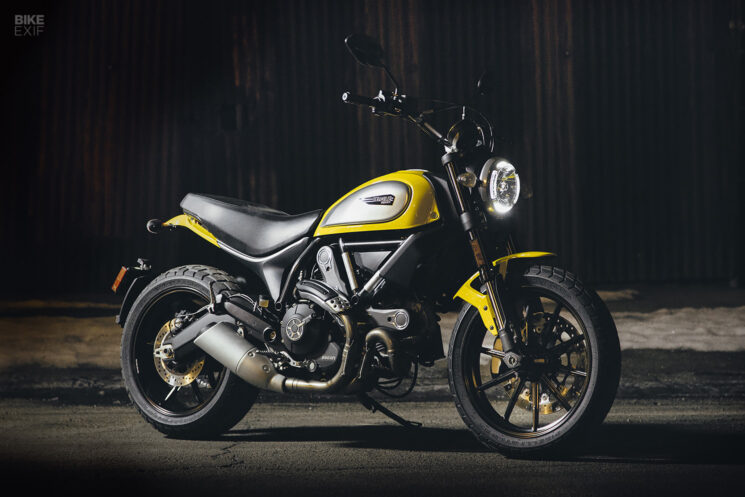
In one of the many promotional videos released by Ducati, we hear the Dandy Warhols sing, “I’m free, no one tells me what to be, ‘cause I know who I am, and I am free” while young and beautiful people race around on the beach on their new Scramblers, staring earnestly out to sea. This display of youthful, devil-may-care attitude may play a little too on-the-nose for those who have been consuming the barrage of YouTube videos from every builder that has turned a wrench for the last few years. This bike isn’t for that rider. It’s for the one that is looking for an alternative to what most of the motorcycle market has had to offer lately.
“I think it’s the perfect motorcycle being introduced at the perfect time,” said Jason Paul Michaels, technical editor for Iron & Air and co-founder of Dime City Cycles. “It’s going to attract a younger more outgoing, experimental crowd. They are going to make that bike their own.”
Jason and his wife, writer and racer Leticia Cline, were among approximately 30 other riders to experience the Scrambler on a press outing in Palm Springs, CA. Jason says that most of the riding was being done on the highway but “the bike was begging – begging – to be beaten against some dirt.” When asked what part of the bike was begging, he half jokes that it was the marketing, then says, “If a product is going to be sold as such, it should be tested as such.”
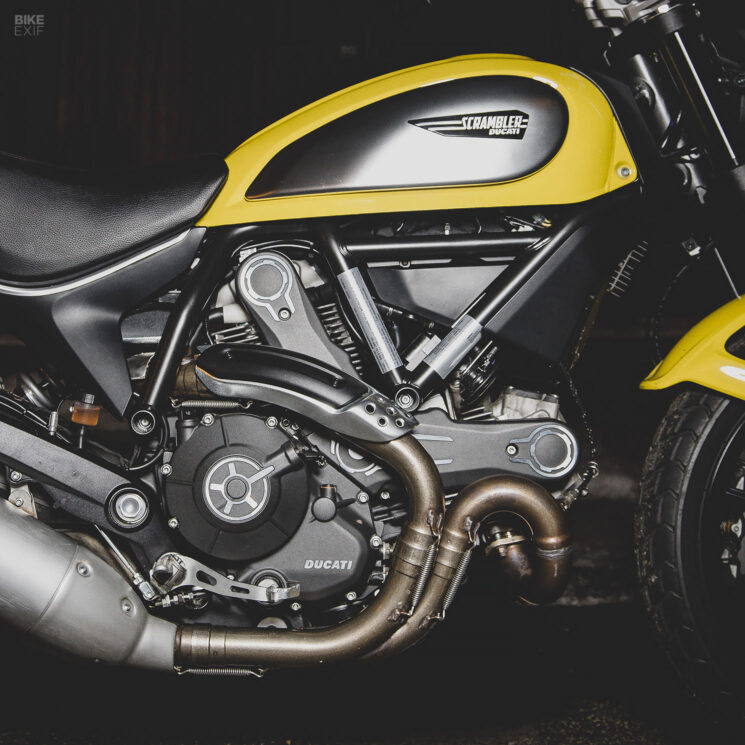
Like the original Scrambler, which took its motor from an existing bike, the Ducati Diana, the new Scrambler is built around an air-cooled, 803 cc variant of the Monster engine. Ducati’s tubular steel trellis frame cradles a desmodromic (relying on a second cam to close the valves instead of a spring) two-valve “L”- twin that produces 75-hp and 50 lb-ft of torque. Designed by the 26-year-old Frenchman Julien Clement, Ducati says that the aesthetics were derived from the question, “What if Ducati had never stopped making the Scrambler?” The result is clean and basic, carrying over the teardrop tank, chunky two-up seat, high and wide handlebars, and simple color scheme.
The modern updates, however, signify that this is a machine built for today. Electronic fuel-injection, ABS, and a six-speed transmission are standard, as are the Pirelli MT 60 dual-sport tires and Kayaba rear mono-shock and inverted front forks. Stopping power is provided by front and rear disc brakes and Brembo calipers. With four available models all coming in a sub-400-lb package, the Scrambler off the showroom floor is a fast, powerful, and nimble machine.
Though most of the riding was done on tarmac, Jason and Leticia did find a way to sneak away from the pack and hit a couple of fire roads. In the dirt, Jason says the Scrambler had its shortcomings. The handlebars were too far forward and a bit wide, the seat was low, and the pegs were too far back. He concedes, though, that as a custom bike builder, he is used to every part of his bike being exactly where he wants, so the Scrambler’s comfort will vary from rider to rider.
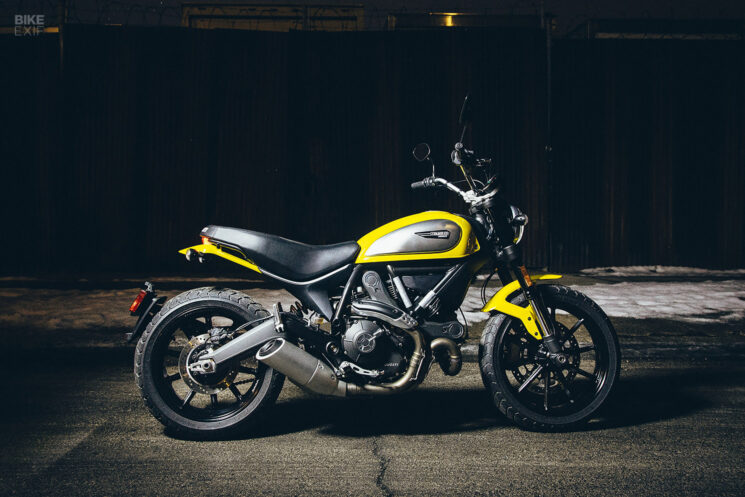
Minor criticisms aside, both Jason and Leticia like the bike. Both believe that the greatest strength of the Scrambler is its inclusivity, allowing anyone to take part in the motorcycle culture. To Jason, this is part of the process of attracting the uninitiated to what it is to be a biker. “If we’re going to captivate motorcyclists to create the next centennial of history, manufacturers have to embrace – I hate that I am going to say this – what’s cool,” said Jason.
The world of motorcycles is a big one. For those that have been toiling in relative obscurity within the small niche of custom motorcycles, there may be apprehensions that Ducati has taken the culture that they have created organically, commoditized it, and is now trying to sell it back to them. But for those like Jason, they see the benefits of a more robust motorcycling community.
“Embracing it will help perpetuate growth and culture for these subsets,” said Jason. “If Ducati sells 50,000 Scramblers over the next eight years and we can gain 1,000, or even 100 core motorcyclists because of the Scrambler, I’m all for it.”
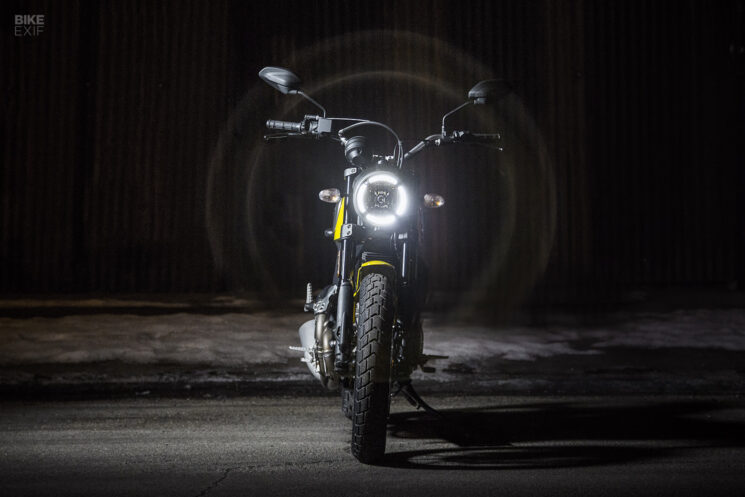
No amount of pandering to the young and beautiful can overshadow that this is a bike that just wants to be ridden – everywhere. Most that get a chance to straddle this machine will be more concerned with how fast and far they go than if they are wearing the right jacket outside of the coolest bar. The people who will appreciate what this bike has to offer are smarter than that.
While riding the Scrambler, Leticia says that she experienced the appreciation of other motorcyclists, giving credence to the notion that the bike can exist outside the demographic that Ducati is seeking. Leticia says she got a nod from a guy on a Ducati Monster at a stoplight and a “Right on!” from another rider on a CT90. All who see the bike are into it.
In a time when people expect more and more from their products, Ducati has built a bike that attempts to be everything to everyone and accessible to all. We can only wait for the crucible of time to determine if they have succeeded. What we know for sure is that we want to be young, to have adventure, and to be free. The Scrambler evokes this by its very being, and in that regard, it’s exactly what we’ve been looking for.
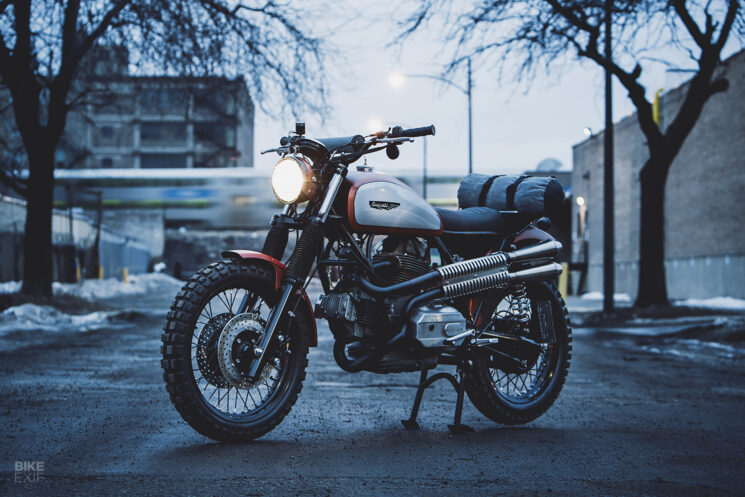
Custom | 1975 Analog Motorcycles Super Scrambler
Air-cooled, four stroke, “L”-twin, SOHC 864 cc | 65 hp | 504 lbs | 5-speed
In the evolution of ideas, there exists a long tradition of simultaneous, yet independent, invention and discovery. And like Elisha Gray and Alexander Graham Bell, who filed patents for the telephone on the same day, two visions of the Ducati Scrambler were unveiled this year: the production bike by Ducati and a one-off build by Tony Prust of Analog Motorcycles.
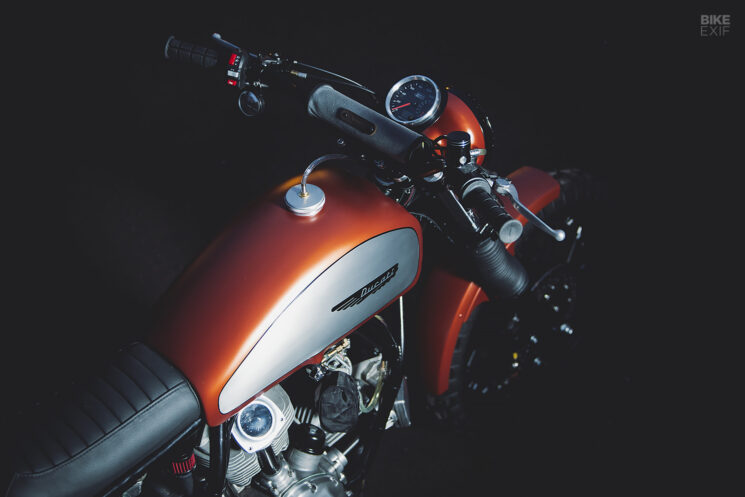
After Del Thompson restored a 1969 Ducati Scrambler, he realized he wanted something that would perform as well as the modern Triumph Scrambler. Thompson contacted Prust, with whom he had collaborated in the past, about the idea of putting together such a project. In early 2014, they put it in the books. Neither had any idea that Ducati was going to be coming out with a factory version at the same time.
After deciding on the 1975 860GT as the platform, Thomas set out to find the donor bike. He found a rolling chas- sis on his first attempt, but the engine was in pieces in a box, and because of the notorious finickiness of the Italian beveled head motor, Prust warned that it would set back the project considerably while they waited for the motor to be put back together. So Thomas sold that bike, found the one they would eventually use, and had it shipped from California.

The build started in July 2014. By November, Prust had the Scrambler up and running.
The urge to compare and contrast the two motorcycles may seem unavoidable since they both came out in such relative proximity of each other, but Prust feels that any comparison between the two is one of apples to oranges. He points to the fact that the ’75 is a much heavier bike than its modern factory counterpart, but he feels that it handles well for what it is. He is also adamant that a true scrambler should have high exhaust pipes.
“I try to keep more of the design elements of the original one in mind as opposed to what they tried to do,” said Prust. “You can see it if you look at theirs, if you look at it closely. The more I stared at it, the more I saw how they tied things in, but it’s very subliminal.”

The response to Prust’s newest build has been overwhelmingly positive. He makes special note that some believe his build to be one of the factory variations. He prides himself on taking the time on every detail of the bike, and that he has honed his craft to such a level. All of his builds come to look factory-perfect. As a result, the sheer amount of work put into his bikes can be lost on the casual observer. “There are so many details that have gone through the cracks,” he says. “That is kind of the irony of some of my builds.”
The serendipity of having two motorcycles unveiled with the same theme allows us all to play “What if?” – to come to a fork in the road and to take both the left and the right. We’re allowed the chance to imagine infinite possibilities within a single genre of motorcycling. We’ve all looked at something that has been produced and said, “If I were to do that, I would have done X, Y, and Z.” With Analog Motorcycle’s take on the classic Scrambler, we don’t have to imagine. Tony Prust has done it for us.
“I think that I captured the soul of what a scrambler motorcycle should be,” he says. “I think a Scrambler should evoke a sense of adventure. If you own one, you shouldn’t be afraid to choose the road less traveled.”

This article first appeared in issue 19 of Iron & Air Magazine, and is reproduced here under license
Words by Ian J.D. Logan | Images by Sean O’Brien
